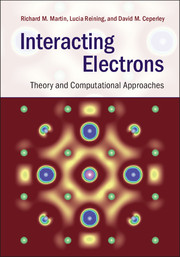Book contents
- Frontmatter
- Dedication
- Contents
- Preface
- Acknowledgments
- Notation
- Part I Interacting electrons: beyond the independent-particle picture
- Part II Foundations of theory for many-body systems
- Part III Many-body Green's function methods
- Part IV Stochastic methods
- 22 Introduction to stochastic methods
- 23 Variational Monte Carlo
- 24 Projector quantum Monte Carlo
- 25 Path-integral Monte Carlo
- 26 Concluding remarks
- Part V Appendices
- References
- Index
24 - Projector quantum Monte Carlo
from Part IV - Stochastic methods
Published online by Cambridge University Press: 05 June 2016
- Frontmatter
- Dedication
- Contents
- Preface
- Acknowledgments
- Notation
- Part I Interacting electrons: beyond the independent-particle picture
- Part II Foundations of theory for many-body systems
- Part III Many-body Green's function methods
- Part IV Stochastic methods
- 22 Introduction to stochastic methods
- 23 Variational Monte Carlo
- 24 Projector quantum Monte Carlo
- 25 Path-integral Monte Carlo
- 26 Concluding remarks
- Part V Appendices
- References
- Index
Summary
… as suggested by Fermi, the time-independent Schrödinger equation … can be interpreted as describing the behavior of a system of particles each of which performs a random walk, i.e., diffuses isotropically and at the same time is subject to multiplication, which is determined by the value of the point function V.
N. Metropolis and S. Ulam, 1949Summary
In the projector quantum Monte Carlo method, one uses a function of the hamiltonian to sample a distribution proportional to the exact ground-state wavefunction, and thereby computes exact matrix elements of it. An importance sampling transformation makes the algorithm much more efficient. In this chapter we introduce and develop the diffusion Monte Carlo method, which involves drifting, branching random walks. For any excited state, including any system with more than two electrons, one encounters the sign problem, limiting the direct application of these algorithms for most fermion systems. Instead, by using approximate fixed-node or fixed-phase boundary conditions, one can achieve efficiency similar to variational Monte Carlo. We also discuss the application of the projector method in a basis of Slater determinants.
In this chapter, we discuss a different quantum Monte Carlo method, projector Monte Carlo (PMC). This general method was first suggested by Fermi [1049]; see the quote at the start of this chapter by two of the inventors of the Monte Carlo method. An implementation of PMC was tried out in the early days of computing [1050]. Advances in methodology, in particular importance sampling, resulted in a significant large-scale application: the exact calculation of the ground-state properties of 256 hard-sphere bosons by Kalos, Levesque, and Verlet [1051] in 1974. Calculations for electronic systems and the fixednode approximation were introduced by Anderson [1052, 1053]. One of the most important projector MC algorithms, the diffusion Monte Carlo algorithm with importance sampling for fermions, was used to compute the correlation energy of homogeneous electron gas by Ceperley and Alder [109] in 1980; the resulting HEG correlation energy was crucial in the development of density functional calculations.
Types and properties of projectors
In this method, a many-body projector G(R, R) = Ĝ is repeatedly applied to filter out the exact many-body ground state from an initial state; the operation of the projector is carried out with a random walk, hence the name of this class of methods.
- Type
- Chapter
- Information
- Interacting ElectronsTheory and Computational Approaches, pp. 609 - 643Publisher: Cambridge University PressPrint publication year: 2016



